Report highlights. According to the most recent available data, for every $1 brands invest in email marketing, they earn $36. This number increases to $45 for the retail, ecommerce, and consumer goods sectors.
- On average, every US$1 invested into email marketing yields $36 in return.
- Companies in the retail, ecommerce, and consumer goods sectors had an even higher return on investment (ROI), at $45 to $1.
- This equates to a 3600% to 4500% ROI.
- Sending 5–8 emails per month provides the highest ROI, averaging $48 per $1 spent.
- Brands with over 10 million subscribers achieve an ROI of $46 per $1 spent, compared to $39 per $1 spent for lists smaller than 500,000 subscribers.
Related reports include How many emails are sent per day | Email marketing statistics | Cold email statistics | Spam email statistics
Email marketing ROI overview
Email marketing consistently delivers a high return on investment (ROI) across various industries and outperforms many other marketing channels.
- The average ROI for email marketing is $36 for every $1 spent, equating to a 3,500% return.
- Email marketing outperforms other channels, with an average ROI of 3,500%, compared to SEO's 317%–1,389% and social media's 250%.
- Businesses that rely primarily on a double opt-in (DOI) method for acquiring subscribers report an ROI of 45:1 on email marketing, while those that mostly use single opt-in (SOI) see a lower return of 40:1.
- In 2023, 52% of marketers saw their email marketing ROI double compared to the previous year. A smaller 5.7% of marketers saw it quadruple, while 12.9% reported no improvement.
- 32% of marketers reported ROI as an effective KPI for measuring the success of their email campaign, compared to conversion rate (41%) and open rate (38%).
- 24% of marketers find it challenging to measure the ROI of their email campaigns.
ROI differences by country/region
- US brands averaged an ROI of $40 for every $1 spent on email marketing, while EU brands reported earning $43 for every $1 spent.
- In the UK, email marketing ROI grew from $40.01 (£29.64) for every pound spent in 2016 to $45.32 (£35.41) in 2020, reflecting a compound annual growth rate (CAGR) of 5.28%.
- 27% of UK marketers use ROI as a metric to evaluate the performance of email marketing, compared to 48% who use sales and 34% who use click-through rates.
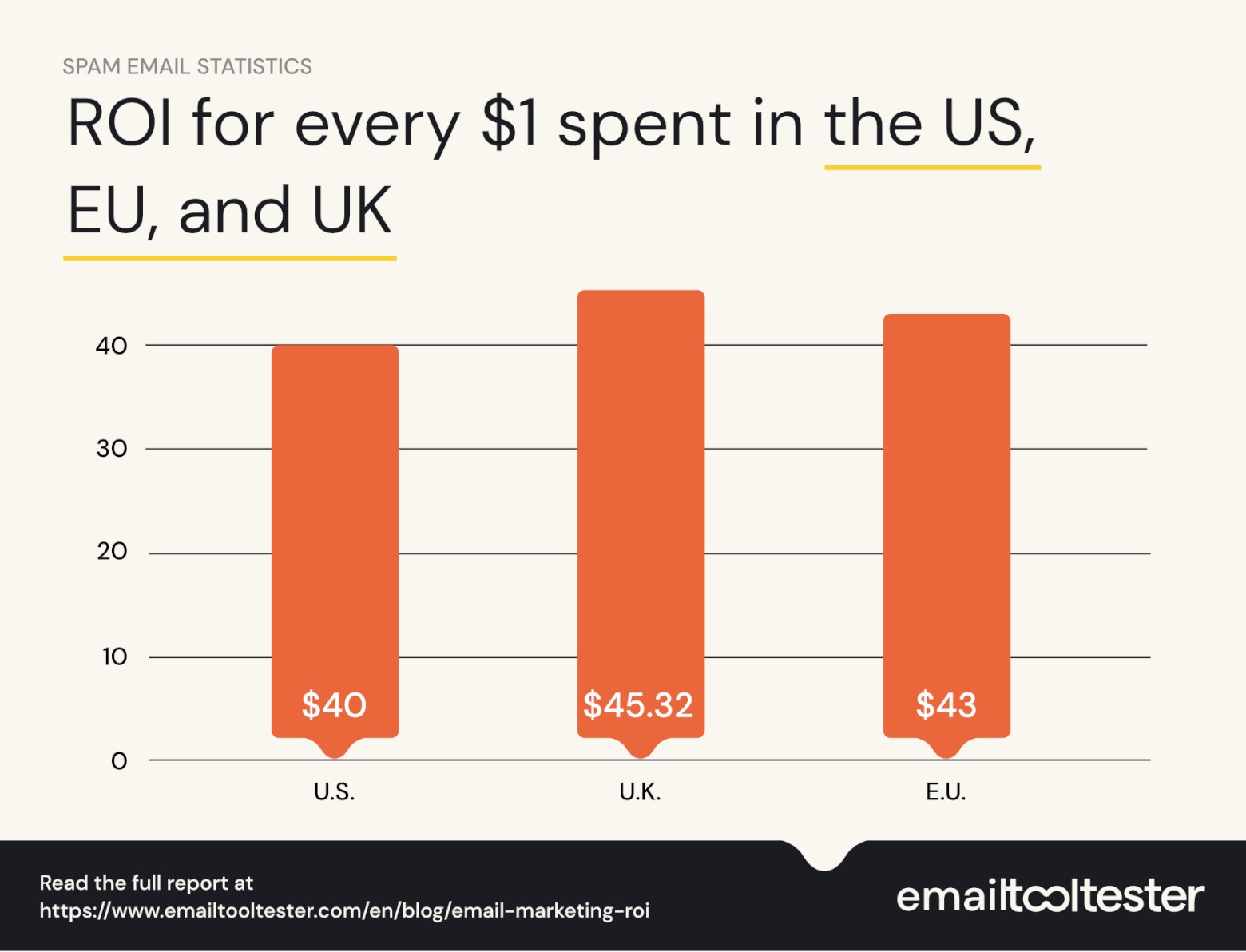
ROI by industry
- The travel, tourism, and hospitality industry reports a significantly higher ROI of $53 for every $1 spent.
- In the retail, ecommerce, and consumer goods sectors, the ROI stands at $45 for every $1 spent.
- Media, publishing, events, sports, and entertainment industries report an ROI of $32 for every $1 spent.
- Software and technology companies see an average ROI of $36 for every $1 spent on email marketing.
- Marketing, PR, and advertising agencies achieve an ROI of $42 for every $1 spent.
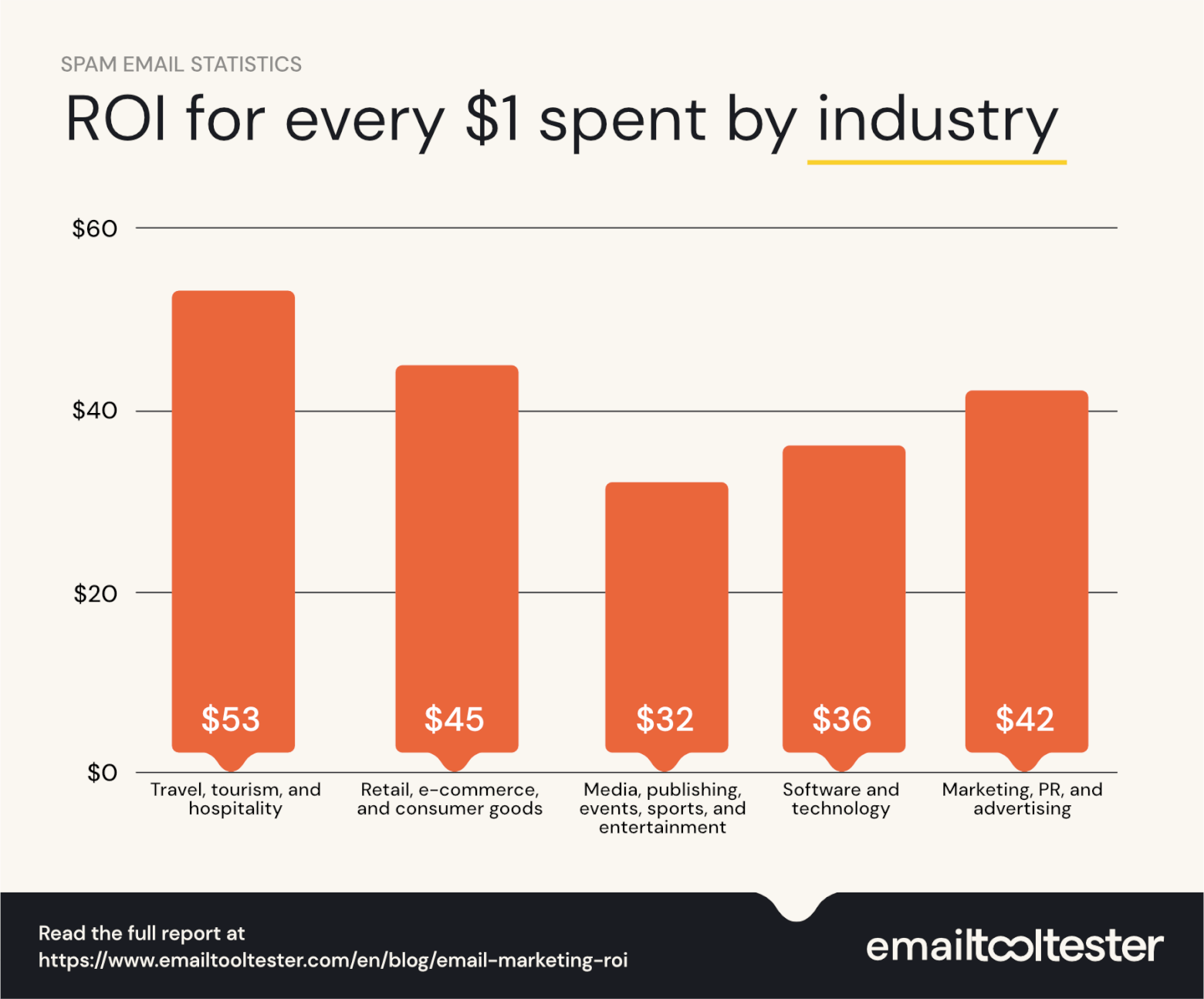
ROI based on company and team size
Company and team size impacts email marketing ROI, and larger companies and teams report better numbers.
- Companies with <100 employees averaged an ROI of $38 for every $1 spent.
- Companies with 100–499 employees reported $40 for every $1 spent.
- Those with >500 employees saw the highest average ROI at $47 for every $1 spent.
- Teams with 2 or fewer full-time email marketers saw an ROI of $42 to $1.
- Teams with 3–5 full-time employees reported a slightly higher ROI of $46 to $1.
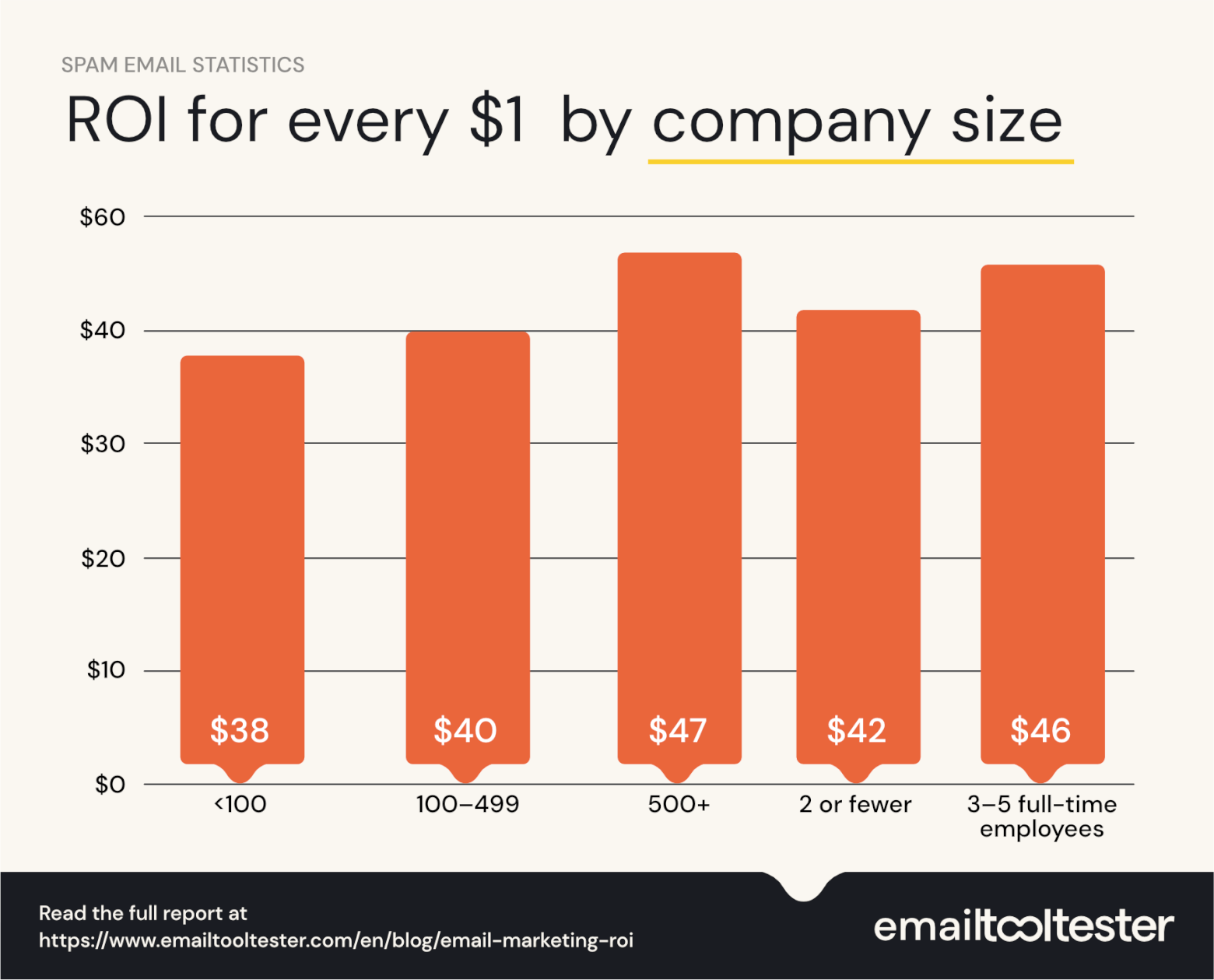
Effect of mailing list size on ROI
In line with the trend for company and team sizes, larger mailing lists reported better ROI.
- Brands with <500,000 subscribers averaged an ROI of $39 for every $1 spent.
- Brands with >500,000 subscribers saw an ROI of $44 to $1.
- Brands with more than 10 million subscribers reported the highest ROI, $46 to $1.
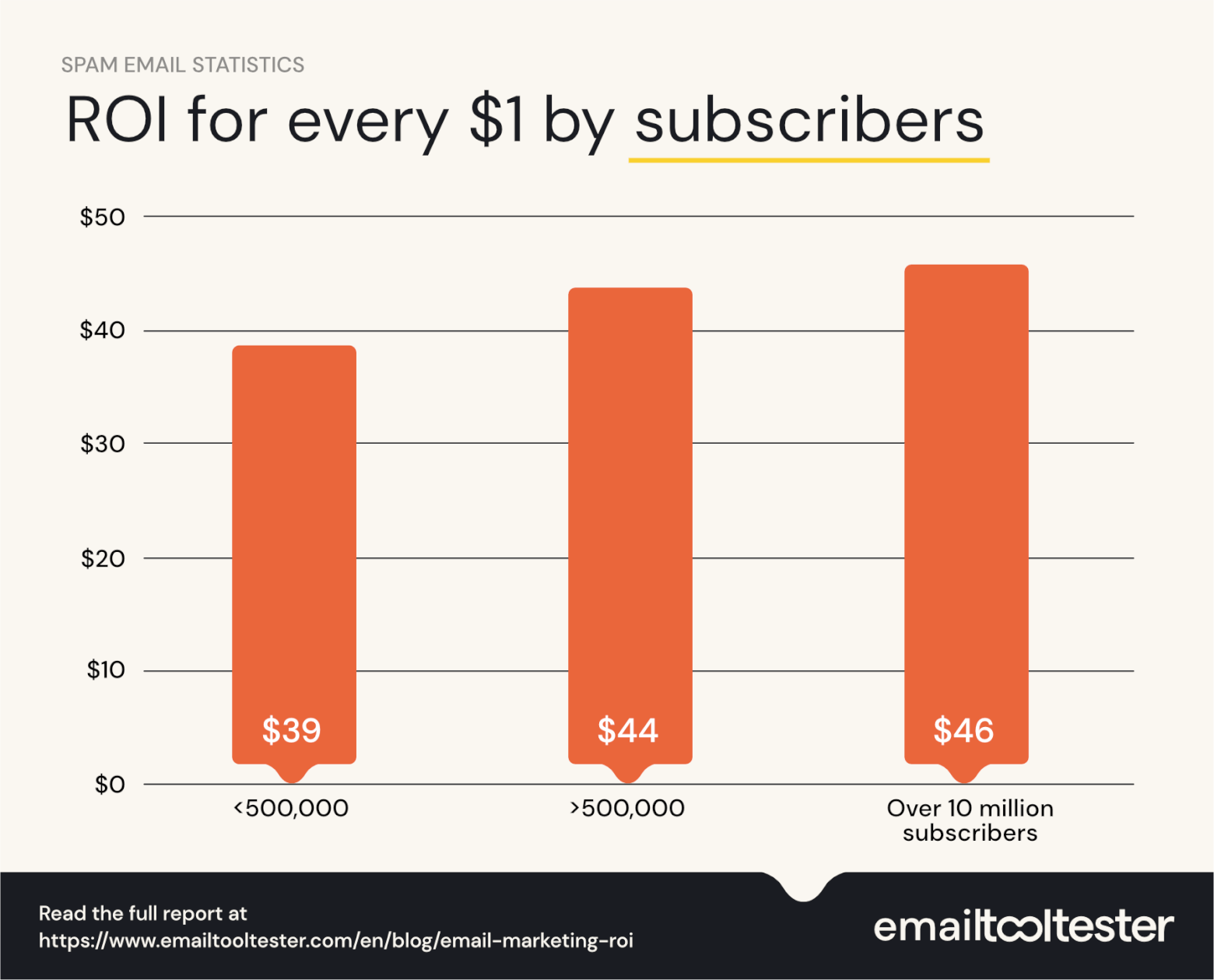
Returns based on sending frequency
Sending an overly low or high number of emails can negatively impact your email marketing ROI.
- Sending 1–4 emails per month resulted in an ROI of $39 to $1.
- Sending 5–8 emails per month delivered the highest ROI at $48 to $1.
- Sending 9+ emails per month offered an ROI of $41 to $1.
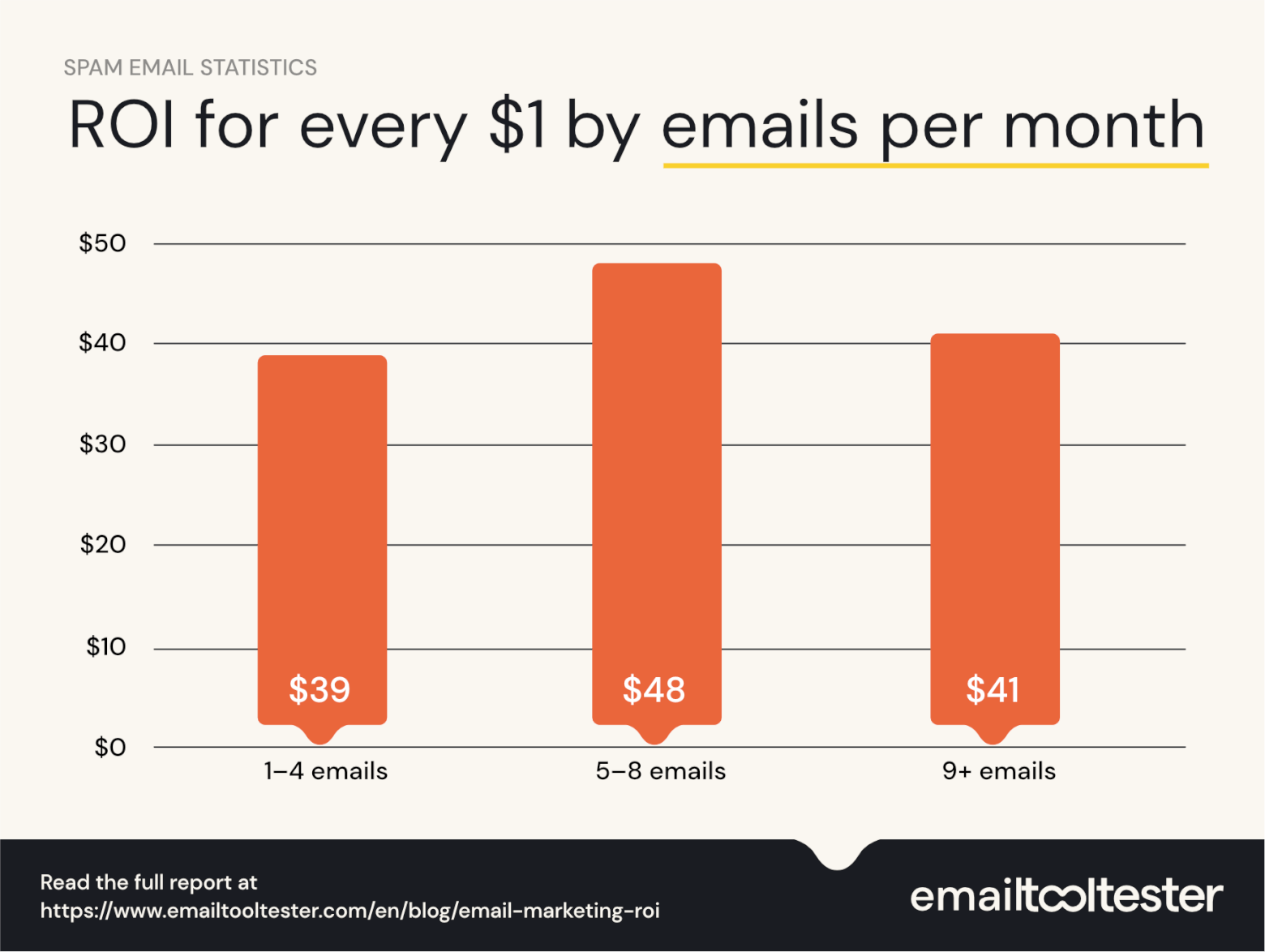
ROI according to content strategy
Content choices such as personalization, visuals, and live elements make a measurable impact on ROI.
- Brands that often or always use dynamic content in their emails report an ROI of $44 for every $1 spent.
- Infrequent or no use of dynamic content dropped ROI to $36 for every $1 spent.
- Emails with animated GIFs often or always boosted ROI to $46 for every $1 spent, while no use of GIFs limited ROI to $38 for every $1 spent.
- Brands that always or frequently use live content reported an ROI of $50 for every $1 spent, while those that never use it averaged a lower ROI of $39 for every $1 spent.
Email open and click rates by industry
Average open and click-through rates (CTR) vary across industries, reflecting differences in audience behavior and engagement levels.
The following is data for open rates and CTR in 2023:
- Legal had the highest CTR at 23.37%, with an open rate of 42%.
- Biotechnology reported a 31% open rate and an 8.75 CTR.
- Engineering saw a 28% open rate and 5.43% CTR.
- Retail had a 14% open rate and 3.34% CTR.
- Education averaged a 26% open rate and a 3.72% CTR.
- Government stood out with a 44% open rate and 7.07% CTR.
- Advertising/marketing had the lowest open rate at 7%.
- Technology had an open rate of 12%, while transportation had an open rate of 15%.
- Industries with the lowest CTRs include transportation at 0.98%, advertising/marketing at 0.97%, and technology at 0.92%, the lowest.
- Across industries, the average email open rate stood at 22% while the average CTR was at 3.57%.
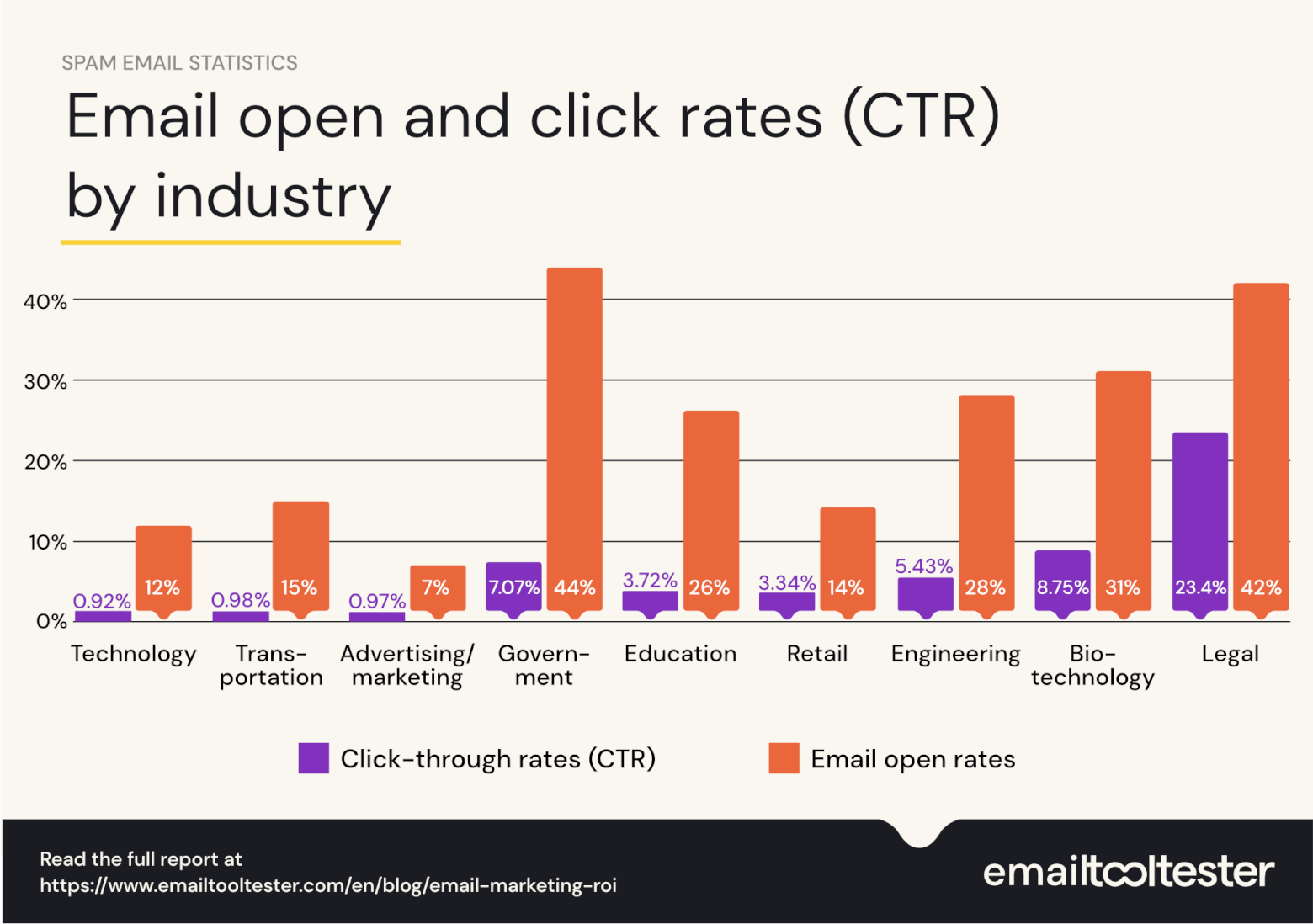
Importance of personalization and automation
- 59% of Americans report that the majority of emails they receive are not useful for them, highlighting the importance of email personalization for increasing ROI.
- On average, automated email campaigns see a 75% increase in open rate and a 114% increase in click-through rate compared to manual email campaigns.
- Personalized email campaigns boost click-through rates by 14% and increase conversion rates by 10%.
B2B vs. B2C email marketing performance
- As of 2023, B2B email campaigns have a higher average CTR (3.28%) than B2C campaigns (2.88%).
- 59% of B2B marketers say email is their most effective channel in terms of revenue generation.
How to calculate your return on investment from email
To calculate your email marketing ROI, subtract your total spent on the email campaign from the total revenue it generated and divide that result by your total expenses. Multiply by 100 for a percentage.

For example, if you earned $1,860 from an email campaign and spent $135 on writing, graphics, and other expenses, your ROI will be:
($1860−$135) ÷ $135 × 100 = 1278%
Here is what counts as revenue and expenses:
- Revenue from email campaigns typically refers to direct sales attributed specifically to email clicks or conversions, usually measured within a defined attribution window, such as 7 or 30 days.
- Tools like Google Analytics or ESP (Email Service Provider) dashboards can help track revenue.
- Expenses include all the costs that you may have incurred for running the campaign, such as ESP subscription charges, design and content-creation expenses, and campaign-promotion expenses and costs for any additional analytics tools or third-party software.
In addition to direct ROI, email marketing can also generate indirect value, such as increased brand awareness, strengthened customer loyalty, and improved lead nurturing.
While these benefits may not appear immediately in direct ROI calculations, they often improve overall long-term marketing performance.
To accurately measure your progress, it's best to use a consistent approach and the same tracking tools when calculating your email marketing ROI over time.
How to improve your ROI
To improve your email marketing ROI, there are a few steps you can take immediately.
- Experiment with conversion optimization strategies, such as improving copy, subject lines, and CTAs, enhancing mobile responsiveness, and streamlining design.
- Segment your email list to send targeted, personalized content that matches subscriber preferences and behavior, increasing engagement and conversions.
- Use dynamic and live content, such as personalized recommendations or countdown timers, to boost interactivity and click-through rates.
- Add an incentive to encourage subscribers to take action, such as offering a limited-time discount, free resources, or exclusive content.
- Balance your email frequency carefully: sending 5–8 emails per month will generate higher returns.
- Regularly test emails, including running A/B tests on subject lines, content formats, and sending frequency to optimize engagement.
- Implement advanced analytics tools beyond your basic ESP dashboards to gain deeper insights into subscriber behavior and campaign effectiveness.
- Improve email deliverability by using the best email service provider.
Campaign types that drive ROI
Certain email campaigns deliver improved ROI by targeting subscribers at key moments in the customer journey.
- Cart abandonment emails offer a high revenue per recipient (RPR) of up to $3.65, with a 50.5% average open rate, 6.25% click-through rate, and 3.33% conversion rate.
- Welcome emails can bring in up to 320% more revenue per email than promotional emails, with 50% average open rates and 14.4% click-through rates.
- Post-purchase emails, such as upsells and product recommendations, drive 90% more RPR compared to regular email campaigns, with open rates up to 217% higher and click-through rates over 500% higher.
- 45% of subscribers who receive a win-back email go on to open future emails from the brand, increasing the likelihood of future conversions and contributing to long-term ROI, despite an average read rate of just 12%.
- Birthday emails see 481% higher transaction rates and 342% more revenue per email than standard promos.
Sources
- Email marketing ROI in selected industries 2020 – Statista
- Email marketing ROI: What leads to better returns?
- Email marketing ROI: Calculate, compare and maximize your return on investment
- Top email marketing ROI statistics you need to know in 2025 – Mailmodo
- Email marketing ROI improve rates 2023 – Statista
- Inbox insights 2022 – Mailjet
- Marketer email tracker 2021 – DMA
- The ROI of email marketing – Litmus
- 2023 email marketing benchmarks – Emfluence Marketing Platform
- The ultimate list of marketing statistics for 2024 – HubSpot
- Email marketing ROI: Statistics & research – Cleverly
- 35 face-melting email marketing stats – WordStream
- The abandoned cart benchmarks report – Klaviyo
- Important welcome email statistics and trends – Invesp
- How to create a post-purchase flow – Klaviyo
- Win-back email examples & strategies for success | Klaviyo
- Email win-back programs report – Validity
- The complete guide to birthday emails – Campaign Monitor
Our Methodology
This article has been written and researched following our EmailTooltester methodology.
Our Methodology

